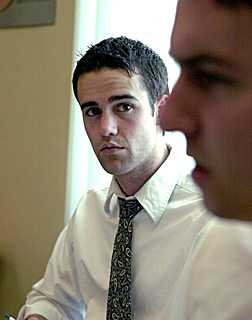 |
|
WILL SEBERGER/Arizona Daily Wildcat
|
ASUA President J.P. Benedict listens to student lobbyist Nick Green discuss a tuition proposal in Benedict's office yesterday afternoon. The Arizona Student's Association hopes not to drive away out-of-state students with higher tuition prices.
|
|
|
By Jeff Sklar
Arizona Daily Wildcat
Tuesday, February 3, 2004
Print this
President Peter Likins will recommend that regents approve the second-largest tuition increase in UA history, a $490 hike for resident undergraduates that would bring next year's rate to $3,998.
Likins will also request tuition hikes of $700 for nonresident undergraduates and graduate students, and $490 for in-state graduate students, he said yesterday.
If regents approve Likins' request, it would mean resident undergraduate tuition rose nearly $1,500 in two years, slightly more than the previous 16 increases combined.
Likins backed off slightly on his plan to increase resident tuition by $500 after other administrators pointed out that the UA could have a pricing advantage over other universities by keeping the cost below $4,000.
A $490 increase would leave UA tuition just short of the top of the bottom third of senior public universities, a level Likins wants to match in the long term.
His plan would also push resident graduate tuition to $4,248, while nudging nonresident undergraduate tuition to $12,978 and nonresident graduate tuition to $13,228.
He emphasized that his proposals this year, especially for nonresidents, were more cautious than last year, when tuition for some students rose as much as $1,500.
"Last year, we pushed that pretty hard and this year ... we're being a little more conservative in our pricing policies," he said.
Student lobbyists countered Likins' request yesterday with a proposal that would raise resident undergraduate and graduate tuition by $400 and all nonresident tuition by $700.
Those increases, they said, would bring about $7.7 million into university coffers, depending on how many students qualify for financial aid. But the increases wouldn't create as severe a strain on students' pocketbooks.
"It's still relatively low tuition for them to attend," said student lobbyist Alexis Coury. "Their accessibility and affordability won't be harmed."
The UA would take in about $1 million less under the student plan than under Likins' plan. But they believe the $90 savings outweighs the extra income for the university.
"It really does make a big difference to a lot of students on this campus," said lobbyist Alistair Chapman, who characterized the $90 difference as enough to pay for two months worth of groceries or a portion of rent.
The lobbyists say they want to see tuition take two years to reach the top of the bottom third nationally. If tuition around the country rises next year at the same rate it has recently, it would take about $800 in the next two years to reach that level.
They cut that figure in half to determine their proposal for next year and have said they hope next year's lobbyists will share their ideas and propose a similar increase.
Likins said the difference between the two proposals was small enough that it shouldn't create a sense of injustice if regents prefer one to the other.
"That means the regents have a decision to make, and the difference between $400 and $490 is, in the scheme of things, a relatively modest difference," he said.
Likins' $490 proposal sounded reasonable to Tra Pham, a junior studying accounting and Spanish, who said that even if tuition increases, she considers the UA a bargain.
|
By the Numbers
Residents
-$490 increase
Program fees for architecture and landscape architecture students $1,000
Nonresidents
- $700 increase
Resident undergraduate application fee $25
|
|
"I guess it's a reasonable amount," she said. "Our education here is pretty cheap compared to other places."
Computer science graduate student Somu Peri agreed, saying that as long as the money goes to improve his education, he wouldn't mind paying the $700 he would have to fork over as an out-of-state resident.
"If it's going to go for better resources, sure," he said.
Likins wouldn't say yesterday precisely how the money would be spent.
He did say, though, that income from last year's tuition hike paid for financial aid, new courses, faculty salaries, employee costs and debt service on buildings, though he expects the Legislature to reimburse the universities for those construction costs beginning in 2008.
In his proposal, Likins also called for $1,000 fees for master's students in architecture and landscape architecture. Those funds would cover technology and equipment costs.
Landscape architecture students, however, won't pay the fee. When the program came under threat of closure last year, professional landscape architects agreed to pay the student fees if it meant keeping the school open, said Ron Stoltz, the program's director.
Likins also recommended a $100 per credit hour fee for graduate students in gerontology and a $202-per-unit increase in the fee for graduate students taking distance-learning courses in engineering.
At least 15 percent of the income from all program fees will be set aside for financial aid.
In his proposal, Likins also requested a $25 application fee for resident undergraduates starting in 2005.
Patti Ota, vice president for enrollment management, said last week that such a fee could generate between $200,000 and $250,000 for recruiting new students.
This year also marked the first time the presidents of ASU and NAU proposed increases different from the UA's.
ASU President Michael Crow asked for a $335 increase for resident undergraduates and NAU President John Haeger called for $475.
The Arizona Board of Regents will set tuition at its March 11-12 meeting at the UA. Program fees will be set in April.
The regents will host a public forum Feb. 25 for students and community members wishing to speak to them about tuition.
Student lobbyists and Student Regent Danelle Kelling will host a forum on tuition today at 4 p.m. in the Kiva Room of the Student Union Memorial Center.
